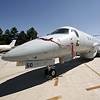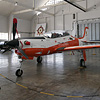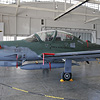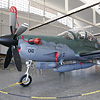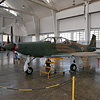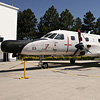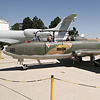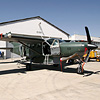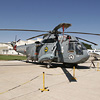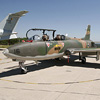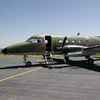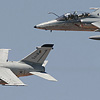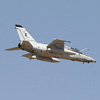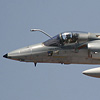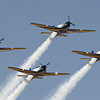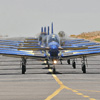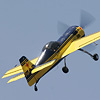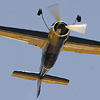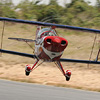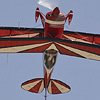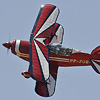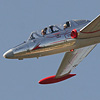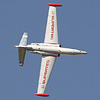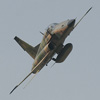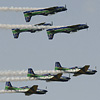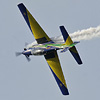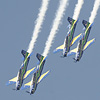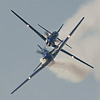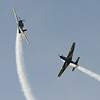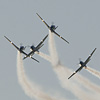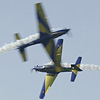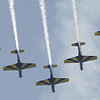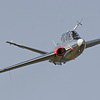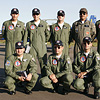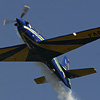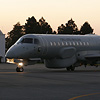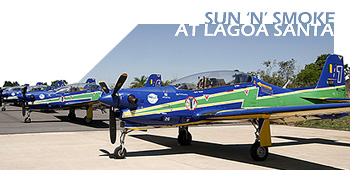
PAMA-LS 2005 Review
Wednesday 12th October
Having attended airshows since 1993 both in Brazil and abroad, there are no doubts in my mind, after so many good (and a few bad) experiences, that there are many intangibles that contribute to make an airshow truly remarkable. Of course, having a well-rounded lineup of aircraft being displayed in the air and on the ground still constitutes the core of what makes an event great, but having a well laid-out display line close enough to the public, some nicely spaced static displays, and first and foremost the full attention and help of the airshow organizers, is almost as crucial. Not surprisingly then, the 2005 Parque de Material Aeronáutico de Lagoa Santa (PAMA-LS) commemoration in central Brazil was one of the best airshow experiences I've ever had, since it was able to provide all of aforementioned positives and much more.
reports from his homeland after attending the Parque de Material Aeronáutico de Lagoa Santa (PAMA-LS) annual commemoration. All photographs by the author.
October is a special month not only for the Força Aérea Brasileira (FAB – Brazilian Air Force), but for all those who do not agree with the widely-shared view in the Anglo-Saxon countries that the Wright Brothers were the first to achieve powered flight. That's because it was on October 23rd, 1906 that Alberto Santos-Dumont, in Bagatelle, France, performed what is considered here the first powered flight in history, flying his 14-Bis over a distance of 50 meters. The major difference between Santos-Dumont's flight and the one performed by the Wright Brothers was that the 14-Bis didn't need a catapult to be able to fly, a feat that earned Santos-Dumont the "Archdeacon Prize" on November 12th, 1906 for solving the problem of making a heavier-than-air machine take-off and fly by its own means.
In order to celebrate this impressive feat, many organizations in the FAB schedule their annual commemorations to take place in the same month Santos-Dumont flew his 14-Bis over France, like, for example, the Parque de Material Aeronáutico de Lagoa Santa (PAMA-LS). The PAMA-LS can trace its origins back to 1935, when work commenced on the construction of Brazil's first aircraft manufacturing plant. Its buildings were built from 1940 onwards, and in 1944, during WWII, the first aeroplanes started to roll off the assembly line. In 1954, the FAB took control of the whole complex, and 20 years later was born the PAMA-LS, which has, since its inception, been responsible for maintaining and inspecting a whole gamut of aircraft in service with our Air Force, like the T-6 and C-47, just to mention two.
Today, the PAMA-LS is entrusted with the crucial task of repairing, overhauling, and manufacturing components for the following fleets: T-27 Tucano (including the Smoke Squadron machines), T-25 Universal, U-7 Seneca, U-42 Regente, L-42 Regente Elo, U-19 Ipanema, TZ-13 Blanik and Z-16 Quero-quero, which are later test-flown by the pilots of Esquadrão Chacal (Jackal Squadron). As if that isn't already enough, this organization also is responsible for the maintenance of all safety, rescue, and survival equipment for the FAB, so all helmets, inflatable boats, life jackets, parachutes, and ejection seats are overhauled and readied for duty by their skilled personnel, a testimony not only to their capabilities, but also of the high quality of the men who command them.
Their 2005 commemoration was scheduled to happen on a national holiday in Brazil, October 12th. One probably couldn't have selected a better day for an airshow, because there was hardly a cloud in the sky, and temperatures were pleasant the whole day, never exceeding 30C. Upon arrival, one would find a very nice range of aircraft from many air bases in Brazil among the static displays, including an A-29 Super Tucano from the 2º/5º GAv, a R-99B from the 2º/6º GAv, an AT-26 Xavante from the 1º/4º GAv, a P-95B Bandeirulha from the 1º/7º GAv, a Navy SH-3 Sea King from HS-1, a T-27 belonging to the Academia da Força Aérea (Air Force Academy), and a rare YT-25 Universal. The aircraft were protected by barriers and well-spaced, a far cry from some shows where it's impossible to get decent shots from the statics…
The flying displays started with a pair of A-1s (official designation of the AMX in the FAB) from the 1º/16º GAv, called Esquadrão Adelphi. These aircraft (a single-seat A-1A and a very nice and not usually seen two-seat A-1B) had to fly all the way from Rio de Janeiro, where they're based, to perform their low altitude passes over Lagoa Santa. Although they were carrying auxiliary tanks, they had a small margin of fuel to play with, and performed just four passes over the crowd. Unfortunately, the pilots never managed to establish radio contact with the event organizers, and flew a little bit away from the display line. Anyway, it was the first time I've seen an A-1A and A-1B in formation, and only their sheer presence was enough to make me happy.
After a C-95B Bandeirante from the 3º ETA took off and dropped around a dozen jumpers, including one with the Brazilian flag, the Smoke Squadron and their seven T-27 Tucanos arrived over Lagoa Santa. Many people in the UK still think they continue to use the old red and white scheme, but the team has dropped those colours quite some time ago, and is currently wearing the new blue, red, yellow and white scheme. This misconception is probably due to the fact it's been some time since they attended a major British airshow, although as recently as July this year the squadron was in Europe taking part in events in Portugal and France. Also of note is the 100 Years of Flight emblem now found right in front of T-27 cockpits – another reminder of how important Santos Dumont's 14-Bis flight in 1906 is for the FAB and Brazilians alike.
The middle part of the show was reserved for the aerobatic displays. The first one to perform was José Berg Filho from Belo Horizonte, Brazil, who arrived at Lagoa Santa with a yellow and blue Sukhoi Su-26M, PT-ZSW, and performed soon thereafter. The Su-26 variants are well known in the aviation circles, and Mr. Berg used its remarkable aerobatic capabilities to full advantage during his display. He was followed by Nelson Tinoco, also from Belo Horizonte, and his beautiful dark red Pitts S-2B, registered PP-ZUB. Although not as agile as the Sukhoi, I've always liked the Pitts better, and a couple of ridiculously low passes over the runway by Mr. Tinoco seemed to reinforce that idea in my mind! To complete those displays, a Christen Eagle, registered PP-ZMG, should have joined the party in the sky, but unfortunately a radio malfunction forced pilot Marcos Geraldi, also from Belo Horizonte, to abort his performance when he was ready to takeoff.
The last three displays were probably the best ones of the day. One aeroplane I was really surprised to find in civilian hands here was the superb Fouga Magister PT-ZIS, a type formerly operated by the FAB as the T-24 and flown by the Smoke Squadron team from 1969 to 1972. Again José Berg Filho was the pilot, and he did some quite remarkable maneuvers I had never seen before with a Fouga, which is, for starters, an underpowered aircraft. After a short break the most anticipated performer of the event turned up, but almost nobody saw it coming. A F-5E Tiger II from the 1º/1º GAvCa, Esquadrão Senta a Pua, came at treetop level at high subsonic speed from behind one of the hangars, and only the sound could be heard before we could realize it had indeed arrived from its base at Rio de Janeiro. The squadron had been deployed to Southern Brazil, and the F-5E came up just for the show. Although it performed only three passes out of the six ones originally scheduled due to fuel concerns, we did get two burner passes before it flew away. For such a small fighter, the F-5E can generate a lot of noise, especially when it is pushed to the limits, as is the case during most displays I've seen the Tigers perform here in Brazil.
To provide a fitting end to the commemoration, the Smoke Squadron performed their full routine before the crowd. Enhanced by the geographical location of the PAMA-LS on a plateau, the seven T-27s didn't fail to please the huge number of people that ran to the display line as soon as they took off. I must say this year's display is probably not as good as the ones I've seen in the past, notwithstanding the fact that all the Smoke Squadron's trademark maneuvers are still performed, like, for example, "the heart", and the "tonneau with inverted wingmen". Anyway, one can't deny the display teams are the reason most people go to airshows worldwide, and that the Smoke Squadron, being one of the best, did their job to showcase the strengths of the FAB to the general public.
One might not be overly impressed with what was displayed during the day, but I rarely have been more satisfied after an airshow was over. Yes, it was not perfect, but no airshow is. But this commemoration had all the subtitles that can make or break a good day out for most enthusiasts. I really had a good time there, and sincerely recommend this event for those who want to see what the FAB is all about – both in the air and on the ground.

